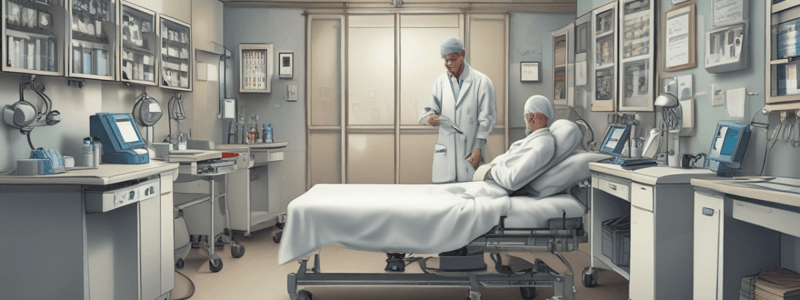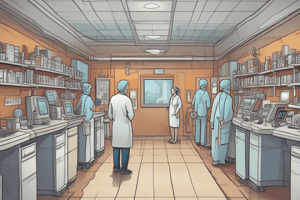Podcast
Questions and Answers
What is the estimated annual number of deaths due to preventable medical error in the inpatient setting?
What is the estimated annual number of deaths due to preventable medical error in the inpatient setting?
- 100,000 to 200,000
- 10,000 to 20,000
- 500,000 to 1,000,000
- 44,000 to 98,000 (correct)
What was the strategy recommended in the 2001 report 'Crossing the Quality Chasm'?
What was the strategy recommended in the 2001 report 'Crossing the Quality Chasm'?
- Increase the number of medical professionals
- Adopt and use technology (correct)
- Implement stricter medical regulations
- Increase funding for medical research
What was the focus of the 2003 report 'Health Professions Education: A Bridge to Quality'?
What was the focus of the 2003 report 'Health Professions Education: A Bridge to Quality'?
- Educational needs in informatics (correct)
- Medical error reduction strategies
- Healthcare policy reform
- Medical research funding
What is the title of the 1999 report that established the significance of preventable medical error?
What is the title of the 1999 report that established the significance of preventable medical error?
Which of the following reports is applicable across practice settings, not just inpatient?
Which of the following reports is applicable across practice settings, not just inpatient?
Which institute published the report 'To Err is Human' in 1999?
Which institute published the report 'To Err is Human' in 1999?
What is the primary purpose of Health IT?
What is the primary purpose of Health IT?
Which of the following is NOT an example of Health IT?
Which of the following is NOT an example of Health IT?
What is the main benefit of Electronic Health Records (EHRs) over paper records?
What is the main benefit of Electronic Health Records (EHRs) over paper records?
What is the primary goal of the HITECH Act of 2009?
What is the primary goal of the HITECH Act of 2009?
What is the main challenge to achieving 100% adoption of Electronic Health Records (EHRs)?
What is the main challenge to achieving 100% adoption of Electronic Health Records (EHRs)?
What is the primary function of Health Information Exchange Organizations?
What is the primary function of Health Information Exchange Organizations?
How does Health IT help pharmacists?
How does Health IT help pharmacists?
What is the primary benefit of Electronic Prescribing?
What is the primary benefit of Electronic Prescribing?
What is a potential negative consequence of automated identification of drug interactions?
What is a potential negative consequence of automated identification of drug interactions?
What is the primary function of Clinical Decision Support?
What is the primary function of Clinical Decision Support?
What is a benefit of barcode medication administration?
What is a benefit of barcode medication administration?
What is a potential negative consequence of barcode medication administration?
What is a potential negative consequence of barcode medication administration?
What is the main goal of interoperability in Health IT?
What is the main goal of interoperability in Health IT?
How do automated dispensing machines improve patient safety?
How do automated dispensing machines improve patient safety?
What is a potential negative consequence of automated dispensing machines?
What is a potential negative consequence of automated dispensing machines?
What is a benefit of patient portals?
What is a benefit of patient portals?
What is a potential negative consequence of patient portals?
What is a potential negative consequence of patient portals?
What is a benefit of telehealth?
What is a benefit of telehealth?
What is a potential negative consequence of telehealth?
What is a potential negative consequence of telehealth?
Why do health IT systems often have safety issues?
Why do health IT systems often have safety issues?
Flashcards are hidden until you start studying
Study Notes
The National Patient Safety Problem
- In 1999, the Institute of Medicine published "To Err is Human," which established that 44,000 to 98,000 people die each year due to preventable medical errors in the inpatient setting.
Technology Is Part of the Solution
- A follow-up to "To Err is Human" was published in 2001, "Crossing the Quality Chasm," which emphasized the adoption and use of technology to improve patient safety across all practice settings.
Informatics Education Needs
- In 2003, "Health Professions Education: A Bridge to Quality" was published, highlighting the need for educational reforms in informatics and integrating it into health professions education through accreditation standards.
Health Information Technology (Health IT)
- Health IT is the use of computer hardware, software, or infrastructure to record, store, protect, and retrieve clinical, administrative, or financial information.
- Examples of health IT include electronic health records, patient portals, electronic prescribing, and clinical decision support.
Influences on Technology Adoption in Health Care
- Factors influencing technology adoption in health care include:
- Desire for improvements in patient safety, quality of care, and efficiency
- Changes in health care payment structures (e.g., value-based care)
- National initiatives (e.g., meaningful use)
- Interoperability (sharing of health information across different electronic health record systems)
The Problem of Paper Records
- Paper records have potential safety problems, such as:
- Illegibility
- Inaccuracy
- Incompleteness
Electronic Health Records (EHRs)
- EHRs are computerized patient care records that can be shared across multiple facilities within a health care system.
- Benefits of EHRs include:
- Comprehensive health information
- Legibility
- Multiple health care professionals can access the record simultaneously
- Greater detail about the patient
The HITECH Act of 2009
- The Health Information Technology for Economic and Clinical Health (HITECH) Act established the position of the National Coordinator for Health Information Technology.
- The act provided economic incentives for adopting and using electronic health records through the "Meaningful Use Program," which is now integrated into Medicare/Medicaid reimbursement programs.
Electronic Health Record Adoption
- Despite the benefits, electronic health record adoption is not yet 100% due to various reasons.
Interoperability
- Interoperability refers to the ability of different health information systems to "talk" to each other.
- Standards such as Fast Healthcare Interoperability Resources (FHIR) are used to facilitate interoperability.
- Health Information Exchange (HIE) organizations connect different health information stakeholders together, enabling the sharing of health information.
Current Level of Interoperability
- The current level of interoperability is achieved through Qualified Health Information Networks (QHINs), which use a network-of-networks model to connect different health information systems.
How Health IT Helps Pharmacists
- Health IT provides pharmacists with access to information that may not always be available.
- Health IT supports the provision of medication therapy management (MTM) and other chronic disease management services.
- Health IT integrates pharmacist-delivered care, including immunizations, into the electronic health record.
Electronic Prescribing/Computerized Prescriber Order Entry (CPOE)
- Electronic prescribing/CPOE improves patient safety by:
- Eliminating legibility issues
- Reducing errors due to leading or trailing zeroes
- However, electronic prescribing/CPOE can also negatively impact patient safety by:
- Sending incorrect information
- Allowing default directions to be sent
Clinical Decision Support (CDS)
- CDS improves patient safety by:
- Automating the identification of drug interactions
- Providing reminders for preventive care
- Adhering to clinical guidelines
- However, CDS can also negatively impact patient safety by:
- Causing alert fatigue, leading to missed alerts and patient harm
Barcode Medication Administration (BCMA)
- BCMA improves patient safety by:
- Providing an additional double-check to ensure the five rights of medication administration
- Ensuring the correct medication is used to fill a prescription
- However, BCMA can also negatively impact patient safety by:
- Allowing workarounds to occur
Barcoding Workarounds
- Common barcoding workarounds include:
- Scanning the same package multiple times
- Skipping barcode scanning
Automated Dispensing Machines (ADMs)/PYXIS
- ADMs/PYXIS improve patient safety by:
- Counting more accurately and faster than humans
- Limiting inappropriate access to medications
- However, ADMs/PYXIS can also negatively impact patient safety by:
- Dispensing or leading to wrong medication (machines are filled by humans)
- Being overridden
Patient Portals
- Patient portals improve patient safety by:
- Providing access to health records
- Enabling secure messaging with health care providers
- Allowing patients to schedule appointments and request medication refills
- However, patient portals can also negatively impact patient safety by:
- Handling urgent care inappropriately
- Perpetuating the digital divide
Telehealth
- Telehealth improves patient safety by:
- Providing access to care that would not otherwise be available to patients
- However, telehealth can also negatively impact patient safety by:
- Lacking a meaningful care relationship
- Perpetuating the digital divide
Why Health IT Has Safety Issues
- Health IT systems are often not developed with significant input from end-users (health care professionals).
- There is variability in the way health IT systems can be used.
- Integrating health IT into clinical workflow requires an adjustment and may seem inefficient, leading to workarounds.
Studying That Suits You
Use AI to generate personalized quizzes and flashcards to suit your learning preferences.




